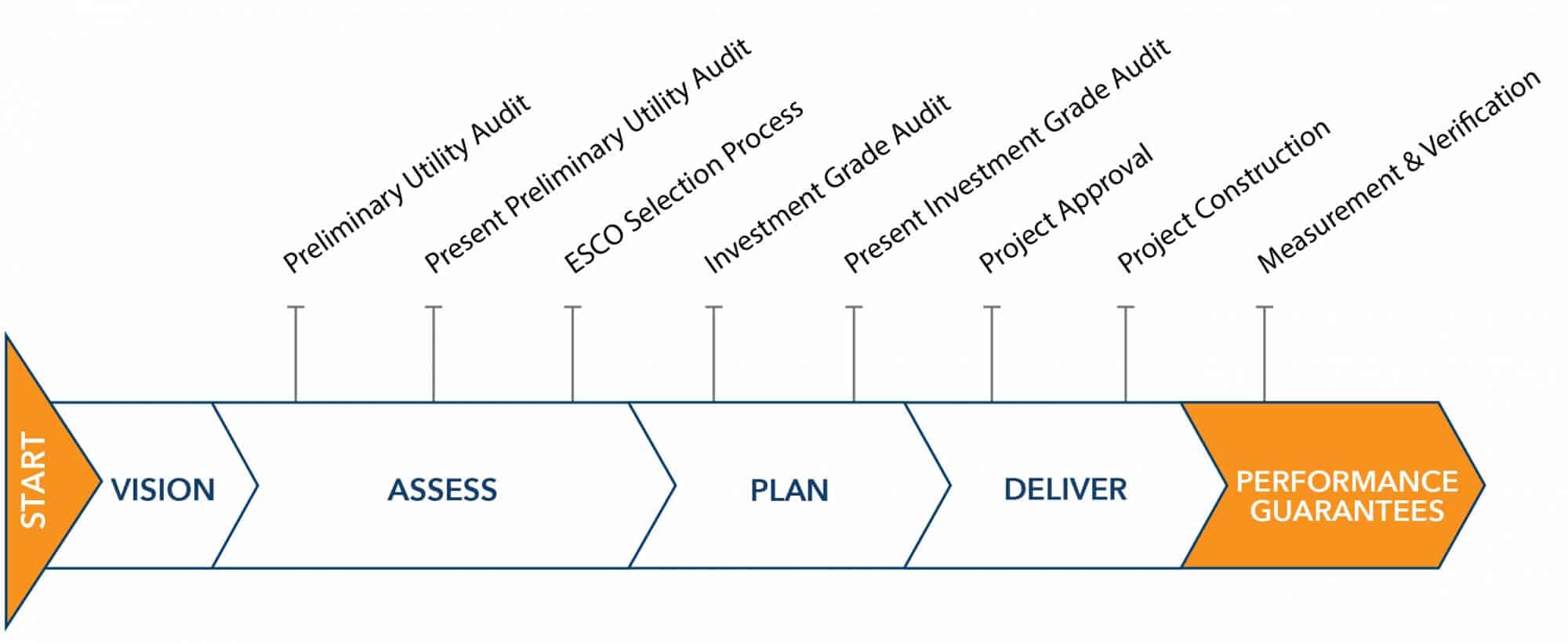Whether you have some familiarity with ESPCs or this is the first time you’ve heard about them, this article will serve as a primer on how to develop and implement a successful project for your institution. Follow along as Ira Nicodemus, Business Development Manager, explains each step to implement Energy Savings Performance Contracts. Let’s get started!
What is an Energy Savings Performance Contract (ESPC)?
Energy Savings Performance Contracts (ESPCs) are a procurement option that allows public entities to finance facility improvements with savings from future operations and maintenance budgets over up to 20 years. This legislation was first enacted in Texas in 1989, and since then, hundreds of municipalities, schools, universities, and hospitals have implemented successful energy savings performance contract projects.
Governing Legislation
For starters, ESPC legislation has been enacted to enable performance contracting in the following public entities in Texas:
- Public Schools (K-12): Title 2, Education Code §44.901
- Local Governments (Cities & Counties): Title 9, Local Government Code §302
- Public Higher Education: Title 3, Education Code §51.927
- State Agencies: Title 10, Texas Government Code §2166.406
- Public hospitals fall within the State or Local jurisdiction of the above codes
Why an ESPC?
Before we get to the how let’s talk about why ESPCs use savings to offset the payment and interest from the financed project cost. Additionally, Energy Service Companies (ESCOs) can provide a savings guarantee. If you don’t get the savings expected, the ESCO pays you the difference. This ensures that your ESPC program is cost-neutral or even cash-flow positive to your Maintenance & Operations budget. Your ESCO should also provide a no change order guarantee, ensuring the agreed-upon project cost doesn’t change during construction.
Texas allows both energy and operations savings from historic baselines to count toward ESPC savings. Additionally, in 2017 the legislation clarified that avoided M&O costs can be considered savings. For example, if you have deferred maintenance or plan to budget $500k for a chiller replacement next year, but you instead replace that chiller as part of the ESPC, you thereby eliminate the need for the $500k budget expense, and the $500k can count as cost avoidance.
Why is this important? The scope of your ESPC can include a variety of energy and water-related measures, but the overall project must pay for itself throughout its term. Some measures, like lighting, smart irrigation, etc., have a quick return on investment, while others, like roofing, windows, and HVAC, can take longer. By balancing and considering all forms of savings, you can create a comprehensive project that takes care of a wide variety of capital needs and allows payment over time. It’s similar to a bond issue without the need for a voter referendum.
Multiple types of financing are allowed for ESPCs, including your cash or bond proceeds, 3rd party financing, or ESCO financing. One of the most common methods is a tax-exempt municipal lease purchase (TELP), as it can be paid within your M&O budget and is not considered debt. TELPs are a powerful tool that allow you to prioritize bond funds for other essential needs, while taking care of infrastructure projects through your existing M&O budget without impacting tax rates.
ESPCs are designed to be large, comprehensive projects with multiple considerations and stakeholders so that the process can take time.
Steps to ESPC Development


Estimated Duration: 14-45 days
Your Commitment: 1-3 meetings with key decision-makers
The ESCO will complete a Preliminary Utility Audit (PUA) and deliver a report. This is a no-cost assessment report of facility conditions (including onsite walk-throughs) and a review of utility bills. The information aims to develop a high-level expectation of potential costs, savings, and scope of work prior to making a decision or financial commitment to move forward.

Estimated Duration: 3-10 days
Your Commitment: 1-3 stakeholder meetings, including decision-makers
Engage all key stakeholders for a review of the PUA report. This may be a multi-step process depending on the complexity of your organization. Consider having a pre-meeting to review with a core group, followed by leadership review, and finally with your board or council.

Estimated Duration: 30-90 days
Your Commitment: RFQ Committee to facilitate solicitation and review of proposals + Board/Council Approval
While you have been working with a specific ESCO up to this point with no long-term or financial commitments made, you now want to select a particular ESCO to move forward with engineering and project development.
Typically, you will follow the steps for procuring professional engineering services as defined in Section 2254.004. This requires a Request for Qualifications (RFQ) selection process. RFQs do not include project pricing but instead focus on the capabilities and performance record of the ESCO. We recommend finding an ESCO that uses open-book pricing and is committed to transparency, as many providers may hide margins of 30-40%.
Alternatively, if you are happy with the ESCO you’ve been working with, you may be able to contract with them directly through a cooperative purchasing agreement. Check with your legal counsel before pursuing this option.
After completing the selection process, you’ll move forward with your selected ESCO to prepare an Investment Grade Audit with a financial obligation for the remaining steps. To document this effort, expect to sign a Letter of Intent

Estimated Duration: 60-90 days
Your Commitment: Site access, multiple meetings with occupants and leadership, building drawings, detailed utility, and operational costs. Cost of study.
In this step, detailed project design and set pricing and savings are developed and delivered in the Investment Grade Audit (IGA). The IGA should be completed by qualified, licensed engineers and will take several weeks of site visits followed by several weeks of detailed calculations, engineering, subcontractor bidding, equipment quotations, etc. Because of this time commitment and level of detail, expect your ESCO to present a fee for the engineering services. This cost is generally rolled into the project, but you’ll be obligated to pay the IGA fee as agreed if the project doesn’t move forward. The exception to this is if the results of the IGA show a significantly different picture than the PUA. In this case, you should be able to walk away with no obligation. This protection is in place to prevent “bait and switch” tactics.

Estimated Duration: 7-10 days
Your Commitment: 1-3 meetings with key decision-makers + Board/Council review and approval
The full IGA document should be reviewed in detail with all stakeholders. This is the opportunity to tweak the scope to ensure the right needs are met.
During this step, you’ll have a 3rd party Professional Engineer (PE) with experience in energy calculations review the IGA and confirm the savings. Your ESCO can help refer a PE, but the independent 3rd party engineer must have a contract with you to avoid potential conflicts of interest. This is an essential step for your protection and is required by the state of Texas.

Estimated Duration: 7-10 days
Your Commitment: Board/Council review and approval
With all the details buttoned up, you will go to your board or council for final approval!

Estimated Duration: 4-18 months
Your Commitment: Support throughout construction
Construction typically takes 4-18 months, depending on the scope of work and seasonal timing. Your ESCO will act as the general contractor and construction manager, ensuring all subcontractors perform correctly and safely to deliver the project on-time and on-budget. To read more about the benefits of a design-build approach, check out this resource article.

Estimated Duration: Ongoing (5-10+ years)
Your Commitment: Access to utility and operations data. Annual board/council meeting results discussion.
If you elected to have savings guarantees in your contract, the ESCO would provide ongoing reports on your building performance. Expect an annual fee for this monitoring service, which should have been negotiated and set before project approval. The first year should be closely monitored every quarter. After Year 1, we suggest you provide annual updates to your leadership and council/board to showcase the good results of your successful ESPC!
Conclusion
Energy Savings Performance Contracts are an excellent construction procurement option for modernizing your facilities and dealing with deferred maintenance issues. The benefits of having a single source of responsibility from a great ESCO will yield years of energy and sustainability benefits while also providing flexibility in your budget.
If you would like to learn more about implementing ESPCs, please reach out to me to discuss further. A detailed document is also included here from the Texas Comptroller’s office.





